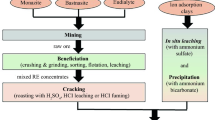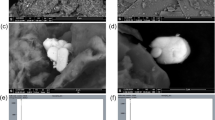Abstract
The concentrations of 238U, 226Ra, 232Th and 40K maintained in phosphate rock (PR), phosphoric acid (PA) and phosphogypsum (PG) samples and its possible radiation hazards, have been measured. The radionuclides in phosphate rock have been redistributed unsymmetrically between phosphoric acid and phosphogypsum during the production process. It is obvious that Ra contributing more than 90% of the potential radiation hazards for PR and PG samples while Ra, Th, and K are contributing the radiation hazards of phosphoric acid. Phosphate rock and phosphogypsum declare higher radiological parameters than the world limit while for phosphoric acid are within the world permissible limits.

Similar content being viewed by others
Change history
30 June 2021
A Correction to this paper has been published: https://doi.org/10.1007/s10967-021-07842-5
References
Hellal F, El-Sayed S, Zewainy R, Amer A (2019) Importance of phosphate pock application for sustaining agricultural production in Egypt. Bull Natl Res Cent 43:1–11
Geissler B, Mew MC, Steiner G (2019) Phosphate supply security for importing countries: developments and the current situation. Sci Total Environ 677:511–523
Fayiga AO, Nwoke OC (2016) Phosphate rock: origin, importance, environmental impacts, and future roles. Environ Rev 24:403–415
Saueia CH, Mazzilli BP, Favaro DIT (2005) Natural radioactivity in phosphate rock, phosphogypsum and phosphate fertilizers in Brazil. J Radioanal Nucl Chem 264(2):445–448
Bolivar JP, Pérez-Moreno JP, Mas JL, Martín JE, San Miguel EG, García-Tenorio R (2009) External radiation assessment in a wet phosphoric acid production plant. Appl Radiat Isot 67(10):1930–1938. https://doi.org/10.1016/j.apradiso.2009.06.004
Abbady AGE, Uosi M, El-Taher A (2005) Natural radioactivity and dose assessment for phosphate rocks from Wadi El-Mashash and E-Mahamid mines Egypt. J Environ Radioact 84(1):65–78
Kolo MT (2014) Natural radioactivity and environmental risk assessment of Sokoto phosphate rock, Northwest Nigeria African. J Environ Sci Technol 8(9):532–538
Cevik U, Baltas H, Tabak A, Damla N (2010) Radiological and chemical assessment of Phosphat rocks in some countries. J Hazard Mater 182(1):531–535
Byrd J (2020) Innovations in Di-Hydrate phosphoric acid plant design for the 2020s. SSRN Electron J. https://doi.org/10.2139/ssrn.3639134
Ben Chabchoubi I, Bouguerra S, Ksibi M, Hentati O (2020) Health risk assessment of heavy metals exposure via consumption of crops grown in phosphogypsum-contaminated soils. Environ Geochem Health. https://doi.org/10.1007/s10653-020-00777-y
Kandil A-H, Mira HI, Taha MH, Kamel MF (2016) Natural radioactivity assessment of El- Sebeaya low grade phosphate rock and hydrochloric acid leaching residue. Int J Nucl Energy Sci Eng 6:26–34
Saadaoui E (2017) Phosphogypsum: potential uses and problems-a review Restauration intégrée des écosystèmes forestiers et leurs adaptations au changement climatique (2020–2023) View project Valorization of phosphogypsum in agronomy View project. Artic Int J Environ Stud 74:558–567
Szajerski P (2020) Distribution of uranium and thorium chains radionuclides in different fractions of phosphogypsum grains. Env Sci Pollut Res 27:15856–15868
Elgafi (2017) Phosphoric Acid and Phosphate Fertilizers 1st Edition. CRC Press; 1st edition
Purnama DS, Damayanti T (2020) Determination of internal and external hazard index of natural radioactivity in well water samples. IOP Conf. Series: Journal of Physics: Conf. Ser. 1436 012090. pp. 1–11
Mazzilli BP, Campos MP, Nisti MB, Saueia CHR, Máduar MF (2020) Radiological implications of using phosphogypsum as building material: a case study of Brazil. Braz J Radiat Sci 8(1):1–29
Farai IP, Ademola JA (2005) Radium equivalent activity concentrations in concrete building blocks in eight Cities in Southwestern Nigeria. J Environ Radioact 79:119–125
Loucks DP, van Beek E (2017) An introduction to probability statistics and uncertainty water resource systems planning and management. Springer, Cham
Taiwo AO, Adeyemo DJ, Sadiq U, Bappah IA (2014) Determination of external and internal hazard indices from natural occurring radionuclide around a superphosphate fertilizer factory in Nigeria. Arch Appl Sci Res 6(1):23–27
Agbalagba EO, Avwiri GO, Chad-Umoreh YE (2012) γ-Spectroscopy measurement of natural radioactivity and assessment of radiation hazard indices in soil samples from oil fields environment of Delta State, Nigeria. J Environ Radioact 109:64–70
Abo-Elmagd M, Soliman HA, Salman KhA, El-Masry NM (2010) Radiological hazards of TENORM in the wasted petroleum pipes. J Environ Radioact, V 101:51–54
Avwiri GO, Olatubosun SA, Ononugbu CP (2014) Evaluation of radiation hazard indices for selected dumpsites in Port Harcourt, Rivers State, Nigeria. Int J Sci Technol 3(10):663–673
Louw I (2020) Potential radiological impact of the phosphate industry in South Africa on the public and the environment (Paper 1). J Environ Radioact 217:106214
Joel ES, Omeje M, Adewoyin OO, Zaidi CEE, Alam SM (2017) Assessment of natural radionuclides and its radiological hazards from tiles made in Nigeria. Radiat Phys Chem 144:43–47
Kehinde A, Christopher O, Blessing OB (2019) Measurement of natural radioactivity and radiological hazard evaluation in the soil samples collected from Owo, Ondo State, Nigeria. J Radiat Res Appl Sci 12:200–209
UNSCEAR (2000) Source and effects of ionizing radiation. Report to General Assembly, with Scientific Annexes. United Nations Scientific Committee on the Effects of Atomic Radiation, United Nations, New York, pp 265–273
Heikal Mohamed ThS, Gomaa SR, Taha AA, Top G, Mahmoud KR, El- Mansi MM, Monsef MAE (2018) Radiological monitoring and statistical analysis of 238U, 232Th, and 40K at Abu dabbab albite Granite Mining Area, Central Nubian Shield Egypt. Int J Environ 7(1):98–121
Zidan Ibrahim H (2019) Environmental assessment of natural radioactivity in Mahamid phosphorite and the related phosphatic fertilizers. Int J Environ 8(3):171–179
Tuo Fei, Peng Xuan, Zhou Qiang, and Zhang Jing (2020) Assessment of natural radioactivity levels and radiological hazards in building materials. Radiation Protection Dosimetry, pp. 1–6. https://doi.org/10.1093/rpd/ncz289.
Boumala D, Mavon C, Belafrites A, Tedjani A, Groetz JE (2018) Evaluation of radionuclide concentrations and external gamma radiation levels in phosphate ores and fertilizers commonly used in Algeria. J Radioanal Nucl Chem 317:501–510
Atta BY, Farhan KN, Abdaljalil RO (2020) Estimation of the radiation hazards indices of organic fertilizers using NaI(Tl) gamma spectrometer. World Sci News 144:126–140
Salih NF, Hussein ZA, and SZS-RP (2019) Undefined environmental radioactivity levels in agricultural soil and wheat grains collected from wheat-farming lands of Koya district, Kurdistan region-Iraq. Radiat Prot Environ 42(4):128–137
Ibraheema Awad A, Atef E-T, Alruwaili May HM (2018) Asssessment of natural radioactivity levels and radiation hazard indices for soil smples from Abha, Saudi Arabia. Results Phys 11:325–330
El-Bahi SM, Sroora A, Mohamed Gehan Y, El-Gendy NS (2017) Radiological impact of natural radioactivity in egyptian phosphate rocks, phosphogypsum and phosphate fertilizers. Appl Radiat Isot 123:121–127
Taskin H, Karavus M, Ay P, Topuzoglu A, Hidiroglu S, Karahan G (2009) Radionuclide concentrations in soil and lifetime cancer risk due to gamma radioactivity in Kirklareli Turkey. J Environ Radioact 100:49–53
Al-Hwaiti MS, Zielinski RA, Bundham JR, Ranville JF, Ross PE (2010) Distribution and mode of occurrence of radionuclides in phosphogypsum derived from Aqaba and Eshidiya Fertilizer Industry South Jordan. Chin J Geochem 29(3):261–269
Macías F, Pérez-López R, Cánovas CR, Carrero S, Cruz-Hernandez P (2017) Environmental assessment and management of phosphogypsum according to European and United States of America regulations. Procedia Earth Planet Sci 17:666–669
IAEA (2003) Guidelines for radioelement mapping using gamma ray spectrometry, Data IAEA, Vienna, 2003 IAEA-TecDoc-1363. ISSN 1011–4289, Vienna
UNSCEAR (2008) Source and Effects of Ionizing Radiation. Report to General Assembly, with Scientific Annexes. United Nations Scientific Committee on the Effects of Atomic Radiation, United Nations, New York, pp 221–297
IAEA, (2013) Radiation Protection and Management of NORM Residues in the Phosphate Industry, Safety Reports Series. No.78, p115–117
Msila X, Labuschagne F, Barnard W, Billing DG (2016) Radioactive nuclides in phosphogypsum from the lowveld region of South Africa. S Afr J Sci 112(1–2):01–05
Al-Attar LA, Al-Oudat M, Kanakri S, Budeir Y, Khalily H, Hamwi AA (2011) Radiological impacts of phosphogypsum. J Environ Manage 92:2151–2158
El-Didamony H, Gado HS, Awwad NS, Fawzy MM, Attallah MF (2013) Treatment of phosphogypsum waste produced from phosphate ore processing. J Hazard Mater 244:596–602
El-Afifi EM, Hilal MA, Attallah MF, El-Reefy SA (2009) Characterization of phosphogypsum wastes associated with phosphoric acids and fertilizers production. J Environ Radioact 100(5):407–412
Al-Jundi J, Al-Ahmad N, Shehadeh H, Afaneh F, Maghrabi M, Gerstmann U, Hollriegl V, Oeh U (2008) Investigation on the activity concentrations of 238U, 226Ra, 210Pb and 40K in Jordan phosphogypsum and fertilizers. Radiat Prot Dosimetry 131(4):449–454
Saleh A, El-Taher A (2016) Assessment of natural radioactivity level and radiation hazards in soil samples of Wadi Al-Rummah Qassim province, Saudi Arabia. J Environ Biol 37:985–991
Kapdan E, Altinsoy N, Karahan G, Taskin H (2011) Determination of the health hazards due to background radiation sources in the city of Adapazari Northwestern Turkey. Isot Environ Health Study 47(1):93–100
Qureshi AA, Tariq S, Din UK, Manzoor S, Calligaris C, Waheed A (2014) Evaluation of excessive lifetime cancer risk due to natural radioactivity in the rivers sediments of Northern Pakistan. J Radiat Res Appl Sci 7:438–447
Author information
Authors and Affiliations
Corresponding author
Additional information
Publisher's Note
Springer Nature remains neutral with regard to jurisdictional claims in published maps and institutional affiliations.
Rights and permissions
About this article
Cite this article
Korany, K.A., Masoud, A.M., Rushdy, O.E. et al. Phosphate, phosphoric acid and phosphogypsum natural radioactivity and radiological hazards parameters. J Radioanal Nucl Chem 329, 391–399 (2021). https://doi.org/10.1007/s10967-021-07796-8
Received:
Accepted:
Published:
Issue Date:
DOI: https://doi.org/10.1007/s10967-021-07796-8




